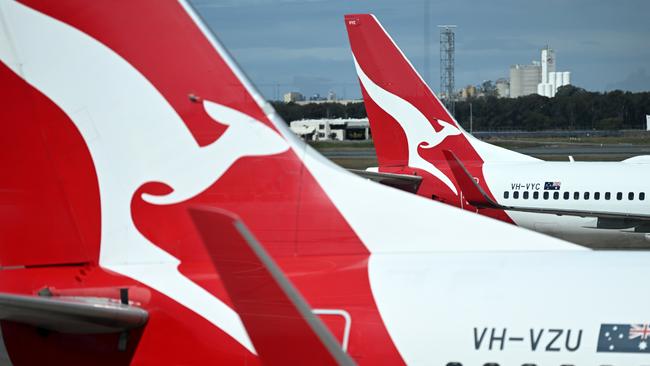Qantas hands out $50 credits in an apology to flyers
The airline is also extending the travel status of customers above the silver tier of its program – including gold and platinum – for another 12 months.

Qantas will gift most of its 14 million frequent flyers a $50 travel credit in a major brand resuscitation exercise for the embattled airline.
The airline is also extending the travel status of customers above the silver tier of its program – including gold and platinum – for another 12 months.
The reward is intended to thank customers for persevering with Qantas in the face of months of poor on-time performance, record cancellations and thousands of mishandled bags.
In a video message sent to frequent flyers, Qantas chief executive Alan Joyce said “the return to flying had not all gone smoothly” and it was not what customers expected from the airline.
“On behalf of the national carrier, I want to apologise and assure you that we’re working hard to get back to our best,” Mr Joyce said.
“Throughout this time, our customers have been very understanding so as well as saying sorry we want to say thank you.”
The $50 travel credit would be available to all Australian and New Zealand-based frequent flyers towards a return Qantas flight.
The Australian first revealed the sweeteners on Sunday. It was estimated the gift to frequent flyers would add about $700m to Qantas’ bank of unused travel credits, on top of the $1bn worth of credits issued over the course of the pandemic, and awaiting redemption.
Qantas’s management of travel credits is currently the subject of an Australian Competition and Consumer Commission investigation.
As part of the brand rebuild, other bonuses were being extended to frequent flyers of silver status and above, including invitations to visit the Qantas Club or international business lounge.
Mr Joyce acknowledged that the most important thing for customers was a “smooth journey” and he offered an assurance Qantas was working towards that.
“We’ve hired 1500 more people since April, we’ve adjusted schedules … to deal with a 50 per cent jump in sick leave and we’re rolling our new technology to make your journey easier,” he said.
“Our teams continue to do an amazing job and with their efforts and the changes we’re making things have already improved.”
Federal government data for July showed Qantas’ on time performance rate was just over 50 per cent for arrivals and departures, and 6.2 per cent of flights or 1201, were cancelled in the month.
The grim figures were attributed to a spike in absenteeism, with 300 pilots calling in sick a day, up from 200 in previous months.
It’s understood on time performance had improved to 66 per cent of flights in August partly due to improved weather and daily meetings of Qantas senior management to tackle issues.
Qantas will announce its full year financial results on Thursday, with a third consecutive loss expected.
For the first six months of the 2022 financial year, Qantas recorded a $1.28bn underlying loss blamed on the impact of Delta lockdowns in Sydney and Melbourne, followed by the end-of-year Omicron outbreak.
Despite a positive outlook for the second half of the year, the airline industry has been rocked by high rates of sickness due to Covid-19 and influenza, bad weather and staffing shortages at airports.
Earlier this month, The Australian reported Qantas had asked its senior executives and managers to join a new contingency program that would see them leave their jobs and work as ground handlers up to five days per week for three months.
In a note to staff, the airline’s chief operating officer Colin Hughes said Qantas would recruit at least 100 managers, adding there was “no expectation that you will opt into this role on top of your full-time position”.
Some analysts have warned that the airline’s financial recovery could be dealt a blow by the poor on-time performance and high cancellation rates.
“While we are optimistic about the long term recovery in travel, we believe the environment is becoming more challenging economically due to fuel and staffing constraints,” Mr Seow wrote. “We expect in the short term, higher fuel prices and overstaffing will put pressure on margins, decrease capacity and increase difficulty for management.”







